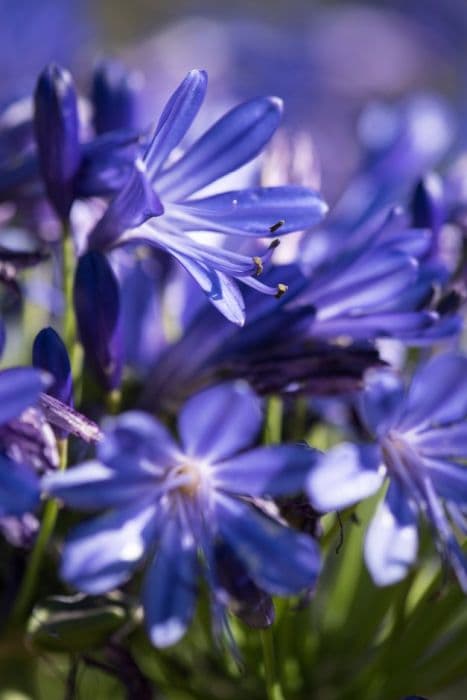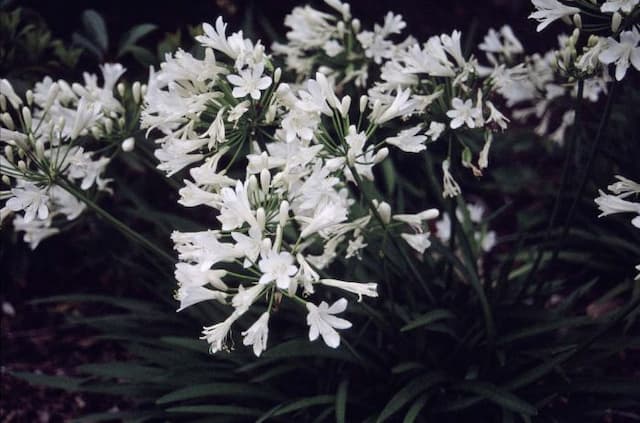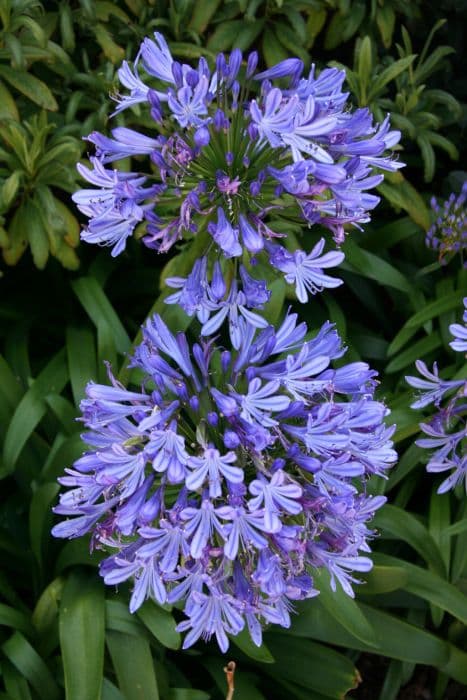Lily of the Nile Agapanthus 'Royal Blue'

ABOUT
Agapanthus 'Royal Blue', commonly known as African Lily or Lily of the Nile, is a striking perennial plant known for its deep blue, trumpet-shaped flowers which are arranged in a large, round cluster at the end of a tall, upright stem. This cluster, often referred to as an umbel, presents a globe-like appearance that is quite showy and bursting with rich color. Each individual flower contributes to the display with its own vibrant blue hue and delicate petal structure, which gracefully flares outwards. The lush florets are complemented by the plant's glossy, dark green leaves that are strap-like in shape, often arching gracefully and forming a dense clump at the base. The contrast of the intense blue floral display against the verdant foliage creates a striking visual spectacle, making the African Lily a popular choice in ornamental gardens and for adding a pop of color in floral arrangements.
About this plant
 Names
NamesFamily
Amaryllidaceae.
Synonyms
African Lily, Lily of the Nile, Agapanthus.
Common names
Agapanthus africanus 'Royal Blue'
 Toxicity
ToxicityTo humans
The plant commonly known as Lily of the Nile is mildly toxic if ingested. It contains substances that can cause gastrointestinal upset such as nausea, vomiting, and diarrhea. Ingesting parts of the Lily of the Nile can also potentially lead to dizziness or other mild toxicity symptoms. It is advised to seek medical attention if any parts of the plant are consumed.
To pets
Lily of the Nile is considered toxic to pets such as dogs and cats. If ingested, it can cause symptoms like nausea, vomiting, diarrhea, and abdominal pain. In more severe cases, it may result in tremors or cardiac issues. Pet owners should be cautious and prevent their pets from chewing on any part of the Lily of the Nile, and consult a veterinarian if they suspect their pet has ingested any part of the plant.
 Characteristics
CharacteristicsLife cycle
Perennials
Foliage type
Evergreen
Color of leaves
Green
Flower color
Blue
Height
3-4 feet [0.9-1.2 meters]
Spread
2-3 feet [0.6-0.9 meters]
Plant type
Bulb
Hardiness zones
8
Native area
South Africa
Benefits
 General Benefits
General Benefits- Ornamental Value: Agapanthus 'Royal Blue', commonly known as Lily of the Nile, features striking blue flowers that can add a splash of color to landscapes and gardens.
- Drought Tolerance: Once established, it is quite drought-resistant, requiring minimal watering and making it suitable for xeriscaping.
- Low Maintenance: It does not require extensive upkeep, making it an excellent choice for gardeners who prefer plants that need less attention.
- Attracts Wildlife: Its flowers are known to attract pollinators such as bees and butterflies, which can help pollinate other plants in the garden.
- Long Blooming Period: Lily of the Nile has a long flowering season, often blooming from early summer into fall, providing prolonged aesthetic appeal.
- Easy Propagation: It can be easily propagated through division, allowing gardeners to spread the plant around their garden or share with others.
- Deer Resistance: The plant is reportedly resistant to deer, making it a suitable choice for gardens in areas with deer pressure.
- Versatility: It can be used in a variety of garden settings, including borders, containers, and as a focal point in garden designs.
 Medical Properties
Medical Properties- This plant is not used for medical purposes
 Air-purifying Qualities
Air-purifying QualitiesThis plant is not specifically known for air purifying qualities.
 Other Uses
Other Uses- African Lily can be used as a natural dye source, with its deep blue flowers potentially yielding colors for fabrics or art materials.
- In photography, the striking flowers of the African Lily provide an excellent subject for macro photography due to their intricate structures and vibrant color.
- The African Lily's robust leaves can serve as a natural writing surface in educational settings, teaching children about plant textures and durability.
- This plant can act as a living fence when planted in a row, creating a natural and aesthetically pleasing boundary for garden spaces.
- African Lily's dried seed pods can be used in floral arrangements to give them an exotic and interesting look, especially in the winter months.
- The foliage can be included in large mixed bouquets for greenery, providing a lush backdrop for other colorful flowers.
- The plant can be grown in containers to decorate balconies and patios where ground planting isn't feasible.
- African Lily can be used in crafting, such as pressed flower art, due to its vibrant flowers and interesting seed pods.
- In environmental education, the plant can be used to demonstrate the concept of bulbous plants and how they store energy.
- Utilized as part of natural playground designs, the African Lily can contribute to sensory gardens for children to explore texture, color, and form.
Interesting Facts
 Feng Shui
Feng ShuiThe African Lily is not used in Feng Shui practice.
 Zodiac Sign Compitability
Zodiac Sign CompitabilityThe African Lily is not used in astrology practice.
 Plant Symbolism
Plant Symbolism- Love Letters: Agapanthus is often known as the "Love Flower," and its 'Royal Blue' variety can symbolize a strong and noble love, as though it is sending a message of deep affection from one person to another.
- Enduring Love: The resilience and enduring nature of the Agapanthus 'Royal Blue' can represent a long-lasting and committed relationship.
- Beauty: With its striking blue flowers, the Agapanthus 'Royal Blue' is commonly associated with beauty and attractiveness, echoing the allure of its blooms.
- Fertility and New Beginnings: In some cultures, Agapanthus flowers are given to wish someone fertility or to celebrate new beginnings due to their lush and proliferative flowering habits.
- Freedom: The Agapanthus 'Royal Blue' can also symbolize freedom, perhaps due to the way its flowers seem to burst open like fireworks.
- Protection: Some believe that Agapanthus has protective qualities, making it a symbol of safety against evil and harm.
 Water
WaterThe Lily of the Nile should be watered regularly, especially during its growing season in spring and summer, to keep the soil evenly moist but not waterlogged. Generally, this means watering deeply once a week with about 1-2 gallons of water depending on the size of the plant and the conditions, such as heat and wind, that would speed up soil drying. In the fall and winter, reduce watering to every other week, providing enough water to prevent the soil from drying out completely. It's important to avoid standing water to prevent root rot, and always check the top inch of soil for dryness before watering again.
 Light
LightLily of the Nile thrives best in full sun to partial shade conditions. The ideal location would be one where the plant is exposed to at least six hours of sunlight per day, though it can tolerate some shade, especially in the afternoon in hotter climates. Ensure that the plant is placed where it can get bright, indirect sunlight if full sun exposure is not possible.
 Temperature
TemperatureFor Lily of the Nile, the ideal temperature range is between 60°F and 85°F. It can survive minimum temperatures down to about 50°F, but frost can severely damage or kill the plant. It can tolerate warmer temperatures but may require additional watering in excessive heat to prevent stress.
 Pruning
PruningPruning the Lily of the Nile is mainly done to remove spent flower stalks and to tidy up any dead or damaged leaves. This should be done after the flowering season ends, typically in early fall. Prune close to the base of the flower stem, and trim off any unsightly foliage, which helps encourage new growth and maintains an attractive shape. Pruning can be done annually or as needed to keep the plant looking its best.
 Cleaning
CleaningAs needed
 Soil
SoilAfrican Lily prefers well-draining soil with compost for fertility. A soil mix consisting of two parts loam, one part perlite or sand, and one part peat or compost is ideal. Maintaining a soil pH between 6.0 to 8.0 will support its healthy growth.
 Repotting
RepottingAfrican Lily should be repotted every 2 to 3 years to refresh the soil. Over time, roots may become crowded, so choose a slightly larger pot to provide more space.
 Humidity & Misting
Humidity & MistingAfrican Lily thrives best at average room humidity levels; around 40-60% is optimal. They are relatively adaptable and don't require high humidity environments.
 Suitable locations
Suitable locationsIndoor
Place in bright, indirect light and water moderately.
Outdoor
Plant in sun to part-shade and shelter from strong winds.
Hardiness zone
8-10 USDA
 Life cycle
Life cycleThe Lily of the Nile 'Royal Blue,' often starts its life as a seed or may be propagated by dividing clumps of mature plants. Germination occurs in warm conditions with adequate moisture, leading to the emergence of seedlings. As they grow, foliage develops into strap-like green leaves and forms clumps. The plant reaches maturity in a few years, at which point it produces tall flowering stems during the summer, topped with spherical clusters of vivid blue flowers. After flowering, seed pods may form, containing seeds that can disperse to propagate the species. During the winter or in colder climates, the plant goes dormant, retreating to its rhizomes underground until the next growth cycle begins in the spring.
 Propogation
PropogationPropogation time
Spring-Early Summer
The most popular method of propagation for the Agapanthus 'Royal Blue', more commonly known as Lily of the Nile, is through division. This is typically done in the early spring as the plant emerges from dormancy or in the fall after the blooming period has ended. To propagate by division, the gardener should carefully lift the plant from the ground and gently separate the clumps of rhizomes, making sure that each division has at least one growing point or fan of leaves. These divisions can then be immediately replanted into well-draining soil, ideally spaced about 12 to 18 inches (30 to 45 centimeters) apart to allow for adequate growth and airflow. Water the newly planted divisions thoroughly to help establish them in their new location.









